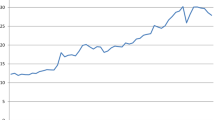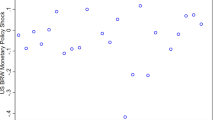Abstract
A central concern with respect to globalization is its effects on institutions. Institutions are thought to provide protections against the casual damage inflicted by market processes and, in various ways, to contribute toward aggregate economic efficiency. The effects of the Canada-United States Free Trade Agreement and the North American Free Trade Agreement on the Canadian labor market and its institutions provide a useful case study of the effects of globalization because Canadian trade is so heavily concentrated with the United States. In this paper I show that, while the agreements imposed considerable costs on employees in some manufacturing industries, overall, Canadian institutions have not been substantially changed by the agreements. Where those institutions have changed, other factors have been much more important.
Similar content being viewed by others
References
Anonymous. (Summer 1999). “Unionization in Canada: A retrospective.”Perspectives in Labour and Income. Statistics Canada, 75-001-XPE 4–35.
Anonymous. (Autumn 2000). “Unionization in Canada: An update.”.Perspectives in Labour and Income. Statistics Canada, 75-001-XPE 39–59.
Aitken, Norma D. (1973). “The effect of EEC and EFTA on European trade: A Temporal Cross-Section Analysis.”American Economic Review, 63: 881–892.
Akyeampong, Ernest B. (Winter 1997). “A statistical portrait of the trade union movement.”Perspectives on Labour and Income. Statistics Canada 75-001-XPE, 45–54.
Arthurs, H.W. (1999). “Constitutionalizing neo-conservatism: TINA × 2.” Thomas J. Courchene, ed.Room to Manoeuvre? Globalization and Policy Convergence. Montreal and Kingston: McGill-Queen's University Press.
Bayoumi, Tamin, and Barry Eichengreen. (1995). “A provincial view of capital mobility.”IMF Staff Papers, 44: 534–556.
Bérubé, Gérard. (2000). “Mosel Vitelic pourrait tomber au combat des fusions.”Le Devior Mardi 12 Décembre: 2.
Bikker, Jacob A. (1987). “An international trade flow model with substitution: An extension of the gravity model.”Kyklos, 40: 315–337.
Britton. Cited in note 16 of Jackson Jackson, Andrew. (1999). “The free trade agreement—a decade later.”Studies in Political Economy, 58: 141–160.
Calmfors, Lars, and John Driffill. (1988). “Bargaining structure, corporatism and macroeconomic performance.”Economic Policy, 2: 14–47.
Campbell, Bruce. (1993). “Restructuring the economy: Canada into the free trade era.” Ricardo Grinspun and Maxwell A. Cameron, eds.The Political Economy of North American Free Trade. Montreal and Kingston: McGill-Queen's University Press.
Canadian Taxpayers Federation. (2000a). Wasted Effort and Dollars?A 13-Year Quantitative Analysis of Western Economic Diversification. Ottawa: Canadian Taxpayers Federation.
-Canadian Taxpayers Federation. (2000b).ACOA: The Lost Decade: A Ten-Year Quantitative Analysis. Ottawa: Canadian Taxpayers Federation.
Clement, Wallace, and Daniel Drache. (1985).The New Practical Guide to Canadian Political Economy. Toronto: J. Lorimer.
Corporate Watch. (1998). “NAFTA at five: A report card.”Corporate Watch: The Watchdog on the Web. www.corpwatch.org/trac/feature/humanrts/globalization/nafta.html.
Drache, Daniel. (1993). “Assessing the benefits of free trade.” Ricardo Grinspun and Maxwell A. Cameron, eds.The Political Economy of North American Free Trade. Montreal and Kingston: McGill-Queen's University Press, 73–87.
-Drache, Daniel, and Meric S. Gertler, eds. (1991).The New Era of Global Competition: State Policy and Market Power. Montreal and Kingston: McGill-Queen's University Press.
Dungan, Peter, and Steve Murphy. (1999).The Changing Industry and Skill of Canada's International Trade. Ottawa: Industry Canada Research Publications.
Ebden, Theresa. (November 3, 1999). “Union activists protest EI moves.”St. John's Telegram, 4.
Eden, Lorraine, and Maureen Appel Molot. (1993).The NAFTA's Automotive Provisions: The Next Stage of Managed Trade. Toronto: C.D. Howe Institute.
Evans, Peter. (1997). “The eclipse of the state? Reflections on stateness in an era of globalization.”World Politics, 50: 62–87.
Fife, Robert. (March 23, 1999). “EI surplus to balloon to $26-billion next year: “Highway robbery.”National Post, A1.
Grinspun, Ricardo. (1993). “The economics of free trade in Canada.” Ricardo Grinspun and Maxwell A. Cameron, eds.The Political Economy of North American Free Trade. Montreal and Kingston: McGill-Queen's University Press, 105–124.
Head, Keith, and John Ries. (1999).Can Small-Country Manufacturing Survive Trade Liberalization? Evidence from the Canada-U.S. Free Trade Agreement. Ottawa: Industry Canada Research Publications.
Hejazi, Walid, and A. Edward Safarian. (1999).Modelling Links between Canadian Trade and Foreign Direct Investment. Ottawa: Industry Canada Research Publications.
Hibbs, Douglas A. (1978). “On the political economy of long-run trends in strike activity.”British Journal of Political Science 8: 153–175.
Hirst, Paul, and Grahame Thompson. (1996).Globalization in Question: The International Economy and the Possibilities for Governance. Cambridge: Polity Press.
Hollingsworth, J. Rogers. (1997). “Continuities and changes in social systems of production: The cases of Japan, Germany, and the United States.” J. Rogers Hollingsworth and Robert Boyer, eds.Contemporary Capitalism: the Embeddedness of Institutions. Cambridge: Cambridge University Press, 265–310.
-Hollingsworth, J. Rogers, and Robert Boyer, eds.Contemporary Capitalism: The Imbeddedness of Institutions. Cambridge: Cambridge University Press.
Jackson, Andrew. (1999). “The free trade agreement—a decade later.”Studies in Political Economy, 58: 141–160.
Laxer, Gordon. (1989).Open for Business: The Roots of Foreign Ownership in Canada Toronto: Oxford University Press.
Levitt, Kari. (1970).Silent Surrender: The Multinational Corporation in Canada. Toronto: McMillan.
Lichfield, Randall. (October 1993). “Wide angle: From $35 billion to zero in a few simple strokes.”Canadian Business, 66: 13.
Lipsey, Richard G., Daniel Schwanen, and Ronald J. Wonnacott. (1994).The NAFTA: What's in, What's out, What's next. Toronto: C.D. Howe Institute.
-Lipsey, Richard G., and Robert C. York. (1988).Evaluating the Free Trade Deal: A Guided Tour through the Canada-U.S. Agreement. Toronto: C.D. Howe Institute.
Marchak, Patricia M. (1979). In Whose Interests: An Essay on Multinational Corporations in a Canadian Context. Toronto: McClelland and Stewart.
-Marchak, Patricia M.. (1985). “Canadian political economy.”Canadian Review of Sociology and Anthropology, 22: 673–709.
Martinello, Felice. (2000). “Mr. Harris, Mr. Rae, and union activity in Ontario.”Canadian Public Policy/Analyse de politiques, 26: 17–33.
McCallum, John. (June 1999). “Two cheers for the FTA.”Policy Options/Options Politiques, 20:6–11.
Murphy, Kevin M., W. Craig Riddell, and Paul Romer. (1998). “Wages, skills and technology in the United States and Canada.” E. Helpman, ed.General Purpose Technologies and Economic Growth. Cambridge: MIT Press, 283–309.
Olewiler, Nancy. (1999). “National tax policy for an international economy: Divergence in a converging world?” Thomas J. Courchene, ed.Room to Manoeuvre? Globalization and Policy Convergence. Montreal and Kingston: McGill-Queen's University Press.
Osterman, Paul. (1988).Employment Futures: Reorganization, Dislocation, and Public Policy. New York: Oxford University Press.
Prince, Michael J. (1988). “New mandate, new money, new politics: Federal budgeting in the post-deficit era.” Leslie A. Pal, ed.How Ottawa Spends 1998–99: Balancing Act: The Post-Deficit Mandate. Toronto: Oxford University Press, 31–55.
Sargent, Timothy C. (1996).An Index of Unemployment Insurance Disincentives. Ottawa: Department of Finance.
-Sargent, Timothy C., and Munir Sheikh. (1996).The Natural Rate of Unemployment: Theory, Evidence and Policy Implications. Ottawa: Department of Finance.
Smith, Michael R. (1999) “Insecurity in the labour market: The case of Canada since the second world war.”Canadian Journal of Sociology 24: 193–224.
-Smith, Michael R.. (2001). “La mondialisation: a-t-elle un effet important sur le marché du travail dans les pays riches?” Forthcoming in Daniel Mercure (ed.),Une société monde? Québec: Presses de l'Université Laval.
Snoddon, Tracy R. (1998). “The impact of the CHST on interprovincial redistribution in Canada.”Canada Public Policy 24: 49–70.
Standing, Guy. (1999).Global Labour Flexibility: Seeking Distributive Justice. London: Macmillan.
Strick, John C. (1999).The Public Sector in Canada: Programs, Finance, and Policy. Toronto: Thompson Educational Publishing.
Trefler, Daniel. (1999).The Long and the Short of the Canada-U.S. Free Trade Agreement. Ottawa: Industry Canada Research Publications.
Trudeau, Gilles, and Guylaine Vallée. (1994). “Economic integration and labour law policy in Canada.” Maria Lorena Cook and Harry C. Katz, eds.Regional Integration and Industrial Relations in North America. Ithaca, New York: New York School of Industrial and Labor Relations, Cornell University, 66–81.
Vastel, Michel. (15 Décembre, 2000). “Mosel Vitelec: Jeux de coulisse.”L'actualité 25: 30–41.
Watson, William. (1998).Globalization and the Meaning of Canadian Life. Toronto: University of Toronto Press.
Wolfson, Michael C., and Brain B. Murphy. (April 1998). “New views on inequality trends in Canada and the United States.”Monthly Labor Review, 3–23.
Author information
Authors and Affiliations
Rights and permissions
About this article
Cite this article
Smith, M.R. What have the FTA and the NAFTA done to the Canadian labor market?. FSSE 30, 25–50 (2001). https://doi.org/10.1007/BF02828501
Issue Date:
DOI: https://doi.org/10.1007/BF02828501




